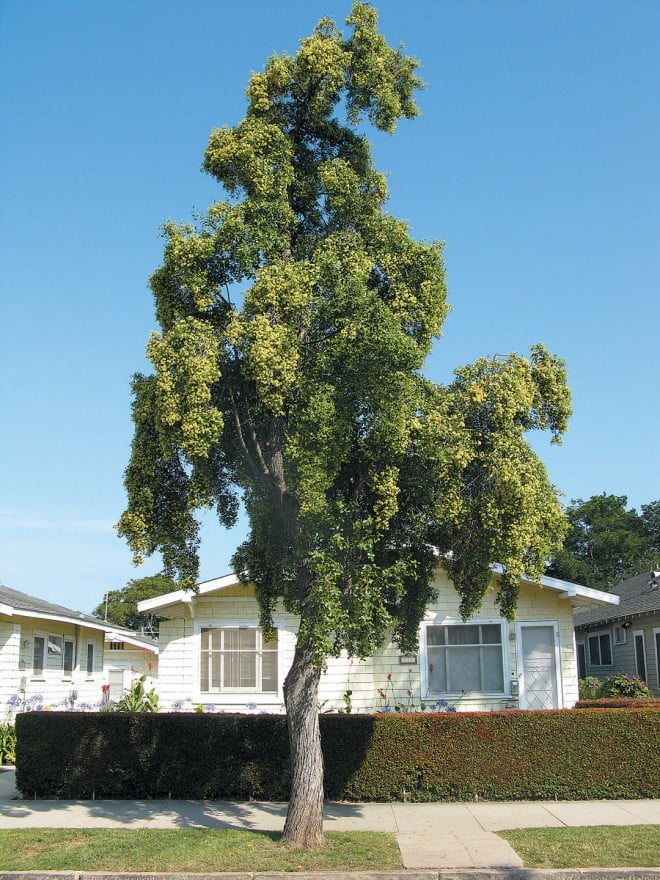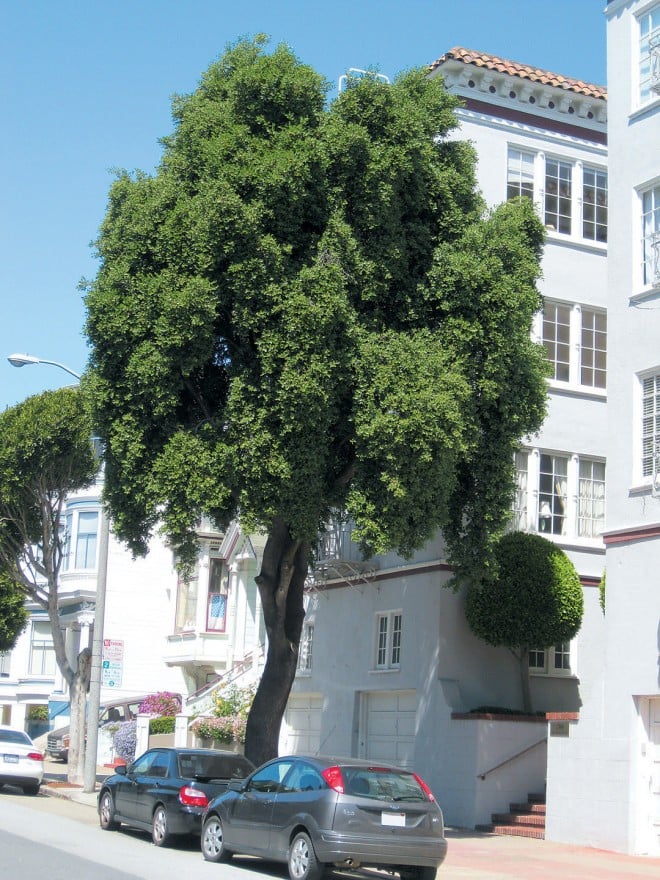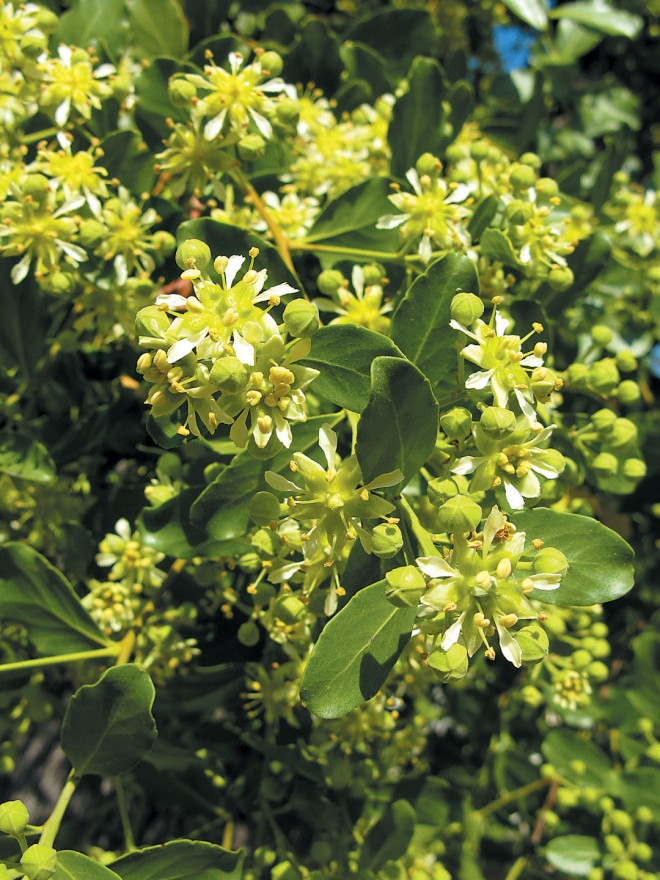

Contributor
- Topics: Archive

Trees native to Chile are not easily found in cultivation in the western United States, constituting less than two percent of species grown in our parks and gardens and along our streets. The most familiar Chilean species are mayten tree (Maytenus boaria), monkey puzzle (Araucaria araucana), and Chilean wine palm (Jubaea chilensis) [see Pacific Horticulture, January 2011]. This paucity of Chilean trees is puzzling, considering the many similarities between the summer dry climates of central Chile and much of the West. Another Chilean native, soapbark tree (Quillaja saponaria), is surprisingly rare, even though it is a beautiful, drought- and cold-tolerant tree that seems to grow well in a variety of conditions.
Soapbark tree is native to central Chile’s narrow mediterranean-climate zone from the coast to above 6,000 feet elevation. As with their respective climates, the similarities in vegetation communities between California and Central Chile are striking. Soapbark is associated with varying habitats, including the matorral, Chile’s equivalent of chaparral, and evergreen woodlands similar to those dominated by oaks in California. In fact, a young soapbark could easily be mistaken for a coast live oak (Quercus agrifolia) at a glance.
A New Family

The genus Quillaja (pronounced key-YAW-haw), which has only three species, all from South America, was first described by the Chilean-born Jesuit, Juan Ignacio Molina. In the 1770s, when Molina wrote his natural and social history of Chile, he was living in Italy after being exiled from Chile, along with many other Jesuits, by the Spanish monarchy. He named the genus Quillaja from the Chilean name for the tree. Until recently, soapbark was considered to be a member of the rose family (Rosaceae), but, because of numerous characteristics atypical for that family (clawed petals, two types of stamens, lobed ovary, and winged seeds), it is now classified in its own family: Quillajaceae.
Soapbark is a moderate to slow-growing evergreen with a narrow, somewhat weeping crown. Some of the largest and oldest specimens in the US are nearly fifty feet tall, although most mature specimens rarely top forty feet in cultivation. Its glossy, dark-green, leathery leaves are worth a careful look. At a glance, they appear to have toothed margins; upon closer inspection, the “teeth” are actually small, water-secreting pores. These pores (called hydathodes) are usually found on non-woody plants growing in wet places. Their function in soapbark leaves is not well understood, but they might exude a nectar that attracts beneficial insects. In early summer, dime-sized, cream-colored flowers with yellow stamens produce abundant (supposedly non-allergenic) pollen. Inconspicuous, leathery, pinwheel-shaped fruits appear in autumn and linger into winter, eventually splitting open to release tiny winged seeds.

Soap and Medicine
Soapbark is famous for the medicinal and commercial use of its inner bark, an abundant source of saponins—a group of bitter-tasting, organic compounds that produce a soap-like foam when shaken in water. The inner bark (sometimes sold as Bois de Panama) is dried, powdered, and used as an emulsifier and foaming agent in cosmetics, shampoos, whipping cream, beer, soft drinks, and even fire extinguishers. Soapbark saponins are supposedly poisonous when consumed at concentrations greater than the minuscule amount added to most commercial products.

In Harry Butterfield’s 1964 Dates of Introduction of Trees and Shrubs to California, soapbark was reported to have arrived in the Bay Area as early as 1878; according to Elizabeth McClintock’s article in the Spring 1984 issue of Pacific Horticulture, this species was cataloged in Golden Gate Park in 1912. For reasons unknown, this species never became popular. Its cold hardiness has been confirmed by Arthur Lee Jacobson, author of Trees of Seattle (2006), who found a thirty-three-foot-tall soapbark tree on the University of Washington campus, planted sometime in the early 1990s, that survived unscathed through 15° F in November 2010. Fine specimens can be found occasionally as street and park trees, but, for a drought-tolerant and cold-hardy, shapely, evergreen tree of a manageable size, they are surprisingly rare. There are several notable trees on the Stanford and UC Berkeley campuses, along Castillo Street in Santa Barbara, on Ferne Street in Palo Alto, and on Sacramento Street in Pacific Heights, San Francisco. Undoubtedly there are many others quietly gracing the streets of cities on the Pacific coast—but still far too few.
Share:
Social Media
Garden Futurist Podcast
Most Popular
Videos
Topics
Related Posts

Ground Up Science for Greener Cities with Garden Futurist Dr. Alessandro Ossola
Spring 2023 Listen to the Podcast here. Alessandro Ossola is a scientist who gets very excited about the challenge of climate change allowing for an

Readying Urban Forests for Climate Realities with Garden Futurist Dr. Greg McPherson
Winter 2023 Listen to the Podcast here. “Going from the mow and blow to a more horticulturally knowledgeable approach to maintaining the landscape. And that

Welcome, Greywater, to the Garden
Summer 2022 Oh, summer: delightful warm air, tomatoes swelling on the vine, fragrant blooms on an evening stroll. When it’s warm and rainless, how is

Big Tree-Data and Big-Tree Data with Garden Futurist Matt Ritter
Summer 2022 Listen to the full Garden Futurist: Episode XV podcast here. We are in an environmental crisis right now in many parts of California










Responses